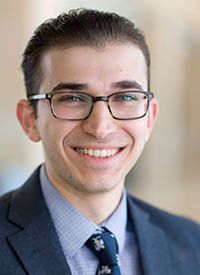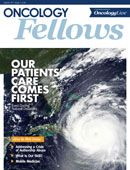Addressing a Crisis of Authorship Abuse
Talal Hilal, MD, on the ethical principles of medical authorship and a just distribution of credit.
Talal Hilal, MD

Talal Hilal, MD
Early on in my training, an email addressed to 16 physicians made its way to my in-box. Within the body of the message was the following statement: “Each of you are listed as coauthors because of your contribution of cases.”
What started of as a research idea under the supervision of 1 mentor and progressed to hours upon hours of data collection, periodic meetings, and synthesis of results was about to be presented as a collaborative efort that included 16 uninvolved individuals! I paused as I read the email and wondered if I could have asked for their help collecting data. That would have hastened the process quite a bit and legitimized the email. Nevertheless, the abstract was submitted with all additional 16 names. “This must have been a mistake!” I thought. “After all, how often do physicians accept credit for work they were not involved in?”
It was always my understanding that those listed as authors made a substantial, direct, and intellectual contribution to the work. In the case of medical authorship, that meant contributing to the conception, design, acquisition of data, and actual writing of the article. This was plausible when 2 or 3 individuals authored scientifc papers, as was the case from the late 1600s until the 1920s.1 However, in today’s world, in which a paper written by 1 author raises red fags and multiple authors are the norm, how plausible is it that 20 authors substantially contributed to an article?2
To ensure some form of regulation, in 1979, the International Committee of Medical Journal Editors (ICMJE) established the Uniform Requirements for Manuscripts Submitted to Biomedical Journals. These guidelines3 have been updated periodically and in their most recent format state that authorship credit should be based on (1) substantial contributions toward the work in areas of conception or design, acquisition, analysis, or interpretation of data; (2) drafting the article or revising it critically for intellectual content; (3) final approval of the version to be published; and (4) agreement to be accountable for all aspects of the work in ensuring that questions related to the accuracy or integrity of any part of the work are appropriately investigated and resolved.4 All 4 requirements must be met. These guidelines are adapted by hundreds of journals and form the ethical backbone of medical authorship.
In the shadow of fierce competition for government funding and institutional requirements for research, opportunistic behavior is rising and leaving in its wake what is called authorship abuse. This manifests in many ways, including coercive authorship, in which an author is listed simply because of senior status over junior investigators; honorary authorship, in which one is awarded authorship out of respect or friendship—also known as gift authorship; mutual support authorship, in which 2 or more investigators place their names on each other’s papers to increase their perceived productivity within the feld; and ghost authorship, in which the true author’s name is omitted from the paper for various deceitful or unjust reasons.5
Authorship of scientifc papers is a mainstay of academic medicine. It does not take long for one to realize that the attraction toward the academic environment has its origins rooted in publishing. Unfortunately, the more time I spend in the academic setting, the more apparent it becomes that in order to publish, I would have to partake in academic misconduct. Perhaps I was naïve enough to have believed that the ethical principles of medical authorship are always upheld or that I can avoid the problem if I so choose. The problem is quite prevalent, as investigators of 1 study estimated that 141 out of 577 (39%) Cochrane reviews have evidence of dishonorable authorship.6
The ethical principles surrounding medical authorship are clearly not being upheld in various realms of the scientifc community and appear to be the most tolerated form of unethical scientific conduct. So, what is the solution?
First, researchers need to realize that the net efect of authorship abuse is profoundly negative. Not only does it place authors who were not intimately involved in the work in a position of responsibility to defend it should the need arise, but, perhaps more importantly, it also discourages junior investigators from further pursuing research when their work is essentially hijacked by the addition of multiple noncontributors masquerading as collaborators.6
Second, journals need to list the specifc contributions of each author and hold all authors accountable for the integrity of their product. This requires logical thinking when examining the number of authors per article. For example, it is unlikely that 10 to 15 authors are substantial contributors toward the conception, design, and drafting of a case series, retrospective study, or review article. If such a response is reported on the ICMJE form, it should be carefully examined and questioned before it is accepted as final.
Third, limit the number of authors for specific papers. This is more easily accomplished with review articles, editorials, and special communications but may be more difcult when applied to original research. An estimate of the number of authors should be applied based on study setting, patient size, and the expected amount of work required. For example, a single-center retrospective chart review of 100 patients is rarely the result of a collaborative effort by 20 authors. On the other hand, multi-institutional prospective clinical trials with thousands of patients are expected to have a larger number of authors.
Fortunately, most impactful journals do follow these guidelines and are keen on maintaining ethical conduct in medical journalism. However, for students, residents, and fellows to attain the highest standards of publication ethics, it is imperative that senior investigators and institutions not only support this endeavor but also consider establishing research policies that minimize authorship abuse. This ultimately will improve research integrity, quality, and productivity if all coauthors participated seriously in the work leading to publication. The attitude that “everyone does it” simply should not be tolerated.7
After all, the goal of what we do revolves around the patient and not ourselves. We owe it to our profession to ensure that the ethical principles of medical authorship are honored and that there is just distribution of credit and acceptance of responsibility.
References
- Greene M. The demise of the lone author. Nature. 2007;450(7173):1165. doi: 10.1038/4501165a.
- Onwude JL, Staines A, Lilford RJ. Multiple author trend worst in medicine. BMJ. 1993;306(6888):1345.
- International Committee of Medical Journal Editors. Uniform requirements for manuscripts submitted to biomedical journals. N Engl J Med. 1997;336(4):309-315. doi: 10.1056/NEJM199701233360422.
- Recommendations for the conduct, reporting, editing, and publication of scholarly work in medical journals. ICMJE website. icmje.org/icmje-recommendations.pdf. Updated December 2017. Accessed March 8, 2018.
- Strange K. Authorship: why not just toss a coin? Am J Physiol Cell Physiol. 2008;295(3):C567-575. doi: 10.1152/ajpcell.00208.2008.
- Flanagin A, Carey LA, Fontanarosa PB, et al. Prevalence of articles with honorary authors and ghost authors in peer-reviewed medical journals. JAMA. 1998;280(3):222-224.
- Eysenbach G. Medical students see that academic misconduct is common. BMJ. 2001;322(7297):1307.
Latest Conference Coverage

Belumosudil Produces Long-Term Responses Without New Safety Concerns in cGVHD

Prophylactic Itacitinib May Safely Mitigate CRS Following Axi-Cel Administration in Lymphoma

Serial ctDNA Testing Could Improve Risk Stratification in High-Risk MIBC

Adjuvant Nivolumab Provides Sustained DFS Benefit, Favors OS in Muscle-Invasive Urothelial Cancer
2 Commerce Drive
Cranbury, NJ 08512
